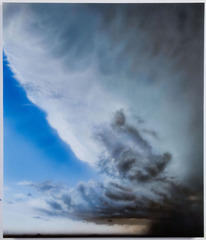Samantha Fields at Kim Light/LightBox
Art in America, Oct, 2007 by Joe Lewis
[ILLUSTRATION OMITTED]
Environmental drama of Shakespearean proportions is the best way to describe the unrestrained atmospheric landscapes that constituted Samantha Fields’s major solo exhibition, “This Land.” The nine medium-size airbrushed canvases (all 2006 or ’07) are synthesized compositions collaged from photographs she took chasing storm cells across the U.S. Fields contemplates the darkest possible outcomes of man’s impact on nature and the ever-present possibility of natural and manmade apocalyptic intrusions–acid rain, global warming, nuclear winters, wildfires, twisters, earthquakes, etc.
The artist’s previous works examined molecular patterns, genetically engineered flora and curiously rodentlike fauna, and the ascent of early man as a dominant force on earth–hairy bipeds brandishing weapons. In spite of her disaster-based mantras and eco-political subtexts, Fields never loses sight of an esthetic informed by the sublime. Her sophisticated, historically grounded gaze, referencing artists as diverse as Bosch and Ross Bleckner, Goya and Beverly Fishman, is as concerned with formal issues as with social consciousness. Now that her work is mostly devoid of people or manmade products, displacement and reclamation are the key metaphors. Storm Anvil over the Great Plains (Nebraska) is in the tradition of Leonardo’s deluge drawings and Thomas Cole’s The Oxbow. Her use of light and shadow further exaggerates the viewer’s perception of movement and pictorial depth, as the storm moves across the canvas–wild cumulonimbus clouds spread their ominous wings over hundreds of miles of heartland as a hopeful, luminous blue sky is sucked into a gargantuan black hole tearing through the lower right quadrant.
Wilderness at Twilight (Yellowstone), the largest of the new paintings, suggests a post-nuclear scenario. Thick, rusty clouds bear down heavily on a thin undulating band of parched earth while simultaneously blotting out life-giving sun. The barely visible remains of a defoliated forest stand tall and populate the brooding terrain as if waiting for something other than their apparent destiny.
Fields’s pictorial solutions are never simple. She builds tension by juxtaposing familiar and idealized iconography with psychologically charged allusions, and she skillfully employs color theory, hyper-narrative and the inherent grandeur of the Western American landscape.
Joe Lewis “Samantha Fields at Kim Light/LightBox”. Art in America. FindArticles.com.

